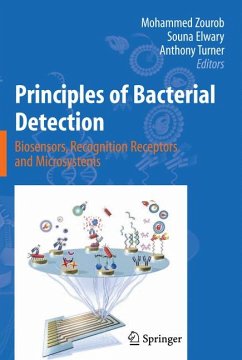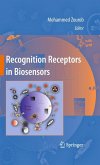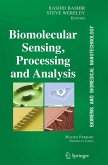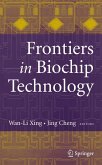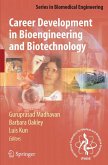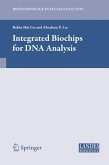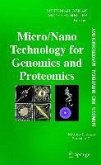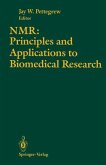Principles of Bacterial Detection: Biosensors, Recognition Receptors and Microsystems (eBook, PDF)
Redaktion: Zourob, Mohammed; Turner, Anthony P. F.; Elwary, Sauna
175,95 €
175,95 €
inkl. MwSt.
Sofort per Download lieferbar

88 °P sammeln
175,95 €
Als Download kaufen

175,95 €
inkl. MwSt.
Sofort per Download lieferbar

88 °P sammeln
Jetzt verschenken
Alle Infos zum eBook verschenken
175,95 €
inkl. MwSt.
Sofort per Download lieferbar
Alle Infos zum eBook verschenken

88 °P sammeln
Principles of Bacterial Detection: Biosensors, Recognition Receptors and Microsystems (eBook, PDF)
Redaktion: Zourob, Mohammed; Turner, Anthony P. F.; Elwary, Sauna
- Format: PDF
- Merkliste
- Auf die Merkliste
- Bewerten Bewerten
- Teilen
- Produkt teilen
- Produkterinnerung
- Produkterinnerung

Bitte loggen Sie sich zunächst in Ihr Kundenkonto ein oder registrieren Sie sich bei
bücher.de, um das eBook-Abo tolino select nutzen zu können.
Hier können Sie sich einloggen
Hier können Sie sich einloggen
Sie sind bereits eingeloggt. Klicken Sie auf 2. tolino select Abo, um fortzufahren.

Bitte loggen Sie sich zunächst in Ihr Kundenkonto ein oder registrieren Sie sich bei bücher.de, um das eBook-Abo tolino select nutzen zu können.
Principles of Bacterial Detection: Biosensors, Recognition Receptors and Microsystems will cover the up-to-date biosensor technologies used for the detection of bacteria. Written by the world's most renowned and learned scientists each in their own area of expertise, Principles of Bacterial Detection: Biosensors, Recognition Receptors and Microsystems is the first title to cover this expanding research field.
- Geräte: PC
- ohne Kopierschutz
- eBook Hilfe
- Größe: 48MB
Andere Kunden interessierten sich auch für
![Recognition Receptors in Biosensors (eBook, PDF) Recognition Receptors in Biosensors (eBook, PDF)]() Recognition Receptors in Biosensors (eBook, PDF)160,95 €
Recognition Receptors in Biosensors (eBook, PDF)160,95 €![BioMEMS and Biomedical Nanotechnology (eBook, PDF) BioMEMS and Biomedical Nanotechnology (eBook, PDF)]() BioMEMS and Biomedical Nanotechnology (eBook, PDF)112,95 €
BioMEMS and Biomedical Nanotechnology (eBook, PDF)112,95 €![Frontiers in Biochip Technology (eBook, PDF) Frontiers in Biochip Technology (eBook, PDF)]() Frontiers in Biochip Technology (eBook, PDF)112,95 €
Frontiers in Biochip Technology (eBook, PDF)112,95 €![Career Development in Bioengineering and Biotechnology (eBook, PDF) Career Development in Bioengineering and Biotechnology (eBook, PDF)]() Career Development in Bioengineering and Biotechnology (eBook, PDF)72,95 €
Career Development in Bioengineering and Biotechnology (eBook, PDF)72,95 €![Integrated Biochips for DNA Analysis (eBook, PDF) Integrated Biochips for DNA Analysis (eBook, PDF)]() Integrated Biochips for DNA Analysis (eBook, PDF)112,95 €
Integrated Biochips for DNA Analysis (eBook, PDF)112,95 €![BioMEMS and Biomedical Nanotechnology (eBook, PDF) BioMEMS and Biomedical Nanotechnology (eBook, PDF)]() BioMEMS and Biomedical Nanotechnology (eBook, PDF)160,95 €
BioMEMS and Biomedical Nanotechnology (eBook, PDF)160,95 €![NMR: Principles and Applications to Biomedical Research (eBook, PDF) NMR: Principles and Applications to Biomedical Research (eBook, PDF)]() NMR: Principles and Applications to Biomedical Research (eBook, PDF)72,95 €
NMR: Principles and Applications to Biomedical Research (eBook, PDF)72,95 €-
-
-
Principles of Bacterial Detection: Biosensors, Recognition Receptors and Microsystems will cover the up-to-date biosensor technologies used for the detection of bacteria. Written by the world's most renowned and learned scientists each in their own area of expertise, Principles of Bacterial Detection: Biosensors, Recognition Receptors and Microsystems is the first title to cover this expanding research field.
Dieser Download kann aus rechtlichen Gründen nur mit Rechnungsadresse in A, B, BG, CY, CZ, D, DK, EW, E, FIN, F, GR, HR, H, IRL, I, LT, L, LR, M, NL, PL, P, R, S, SLO, SK ausgeliefert werden.
Produktdetails
- Produktdetails
- Verlag: Springer US
- Seitenzahl: 970
- Erscheinungstermin: 3. September 2008
- Englisch
- ISBN-13: 9780387751139
- Artikelnr.: 37286900
- Verlag: Springer US
- Seitenzahl: 970
- Erscheinungstermin: 3. September 2008
- Englisch
- ISBN-13: 9780387751139
- Artikelnr.: 37286900
- Herstellerkennzeichnung Die Herstellerinformationen sind derzeit nicht verfügbar.
to Pathogenic Bacteria.- Sample Preparation - An Essential Prerequisite for High-Quality Bacteria Detection.- Detection of Bacterial Pathogens in Different Matrices: Current Practices and Challenges.- Overview of Rapid Microbiological Methods.- Biosensors.- Surface Plasmon Resonance (SPR) Sensors for the Detection of Bacterial Pathogens.- Bacterial Detection Using Evanescent Wave-Based Fluorescent Biosensors.- Fiber Optic Biosensors for Bacterial Detection.- Integrated Deep-Probe Optical Waveguides for Label Free Bacterial Detection.- Interferometric Biosensors.- Luminescence Techniques for the Detection of Bacterial Pathogens.- Porous and Planar Silicon Sensors.- Acoustic Wave (TSM) Biosensors: Weighing Bacteria.- Amperometric Biosensor for Pathogenic Bacteria Detection.- Microbial Genetic Analysis Based on Field Effect Transistors.- Impedance-Based Biosensors for Pathogen Detection.- Label-Free Microbial Biosensors Using Molecular Nanowire Transducers.- Magnetic Techniques for Rapid Detection of Pathogens.- Cantilever Sensors for Pathogen Detection.- Detection and Viability Assessment of Endospore-Forming Pathogens.- Label-Free Fingerprinting of Pathogens by Raman Spectroscopy Techniques.- Biorecognition.- Antibodies and Immunoassays for Detection of Bacterial Pathogens.- Rapid Nucleic Acid-Based Diagnostics Methods for the Detection of Bacterial Pathogens.- Oligonucleotide and DNA Microarrays: Versatile Tools for Rapid Bacterial Diagnostics.- Pathogenic Bacterial Sensors Based on Carbohydrates as Sensing Elements.- Aptamers and Their Potential as Recognition Elements for the Detection of Bacteria.- Protein Microarray Technologies for Detection and Identification of Bacterial and Protein Analytes.- Bacteriophage: Powerful Tools for the Detection of BacterialPathogens.- Phage Display Methods for Detection of Bacterial Pathogens.- Molecular Imprinted Polymers for Biorecognition of Bioagents.- Microsystems.- Microfluidics-Based Lysis of Bacteria and Spores for Detection and Analysis.- Detection of Pathogens by On-Chip PCR.- Micro and Nanopatterning for Bacteria- and Virus-Based Biosensing Applications.- Microfabricated Flow Cytometers for Bacterial Detection.- Bacterial Concentration, Separation and Analysis by Dielectrophoresis.- Ultrasonic Microsystems for Bacterial Cell Manipulation.- Recent Advances in Real-time Mass Spectrometry Detection of Bacteria.
to Pathogenic Bacteria.- Sample Preparation - An Essential Prerequisite for High-Quality Bacteria Detection.- Detection of Bacterial Pathogens in Different Matrices: Current Practices and Challenges.- Overview of Rapid Microbiological Methods.- Biosensors.- Surface Plasmon Resonance (SPR) Sensors for the Detection of Bacterial Pathogens.- Bacterial Detection Using Evanescent Wave-Based Fluorescent Biosensors.- Fiber Optic Biosensors for Bacterial Detection.- Integrated Deep-Probe Optical Waveguides for Label Free Bacterial Detection.- Interferometric Biosensors.- Luminescence Techniques for the Detection of Bacterial Pathogens.- Porous and Planar Silicon Sensors.- Acoustic Wave (TSM) Biosensors: Weighing Bacteria.- Amperometric Biosensor for Pathogenic Bacteria Detection.- Microbial Genetic Analysis Based on Field Effect Transistors.- Impedance-Based Biosensors for Pathogen Detection.- Label-Free Microbial Biosensors Using Molecular Nanowire Transducers.- Magnetic Techniques for Rapid Detection of Pathogens.- Cantilever Sensors for Pathogen Detection.- Detection and Viability Assessment of Endospore-Forming Pathogens.- Label-Free Fingerprinting of Pathogens by Raman Spectroscopy Techniques.- Biorecognition.- Antibodies and Immunoassays for Detection of Bacterial Pathogens.- Rapid Nucleic Acid-Based Diagnostics Methods for the Detection of Bacterial Pathogens.- Oligonucleotide and DNA Microarrays: Versatile Tools for Rapid Bacterial Diagnostics.- Pathogenic Bacterial Sensors Based on Carbohydrates as Sensing Elements.- Aptamers and Their Potential as Recognition Elements for the Detection of Bacteria.- Protein Microarray Technologies for Detection and Identification of Bacterial and Protein Analytes.- Bacteriophage: Powerful Tools for the Detection of BacterialPathogens.- Phage Display Methods for Detection of Bacterial Pathogens.- Molecular Imprinted Polymers for Biorecognition of Bioagents.- Microsystems.- Microfluidics-Based Lysis of Bacteria and Spores for Detection and Analysis.- Detection of Pathogens by On-Chip PCR.- Micro and Nanopatterning for Bacteria- and Virus-Based Biosensing Applications.- Microfabricated Flow Cytometers for Bacterial Detection.- Bacterial Concentration, Separation and Analysis by Dielectrophoresis.- Ultrasonic Microsystems for Bacterial Cell Manipulation.- Recent Advances in Real-time Mass Spectrometry Detection of Bacteria.
